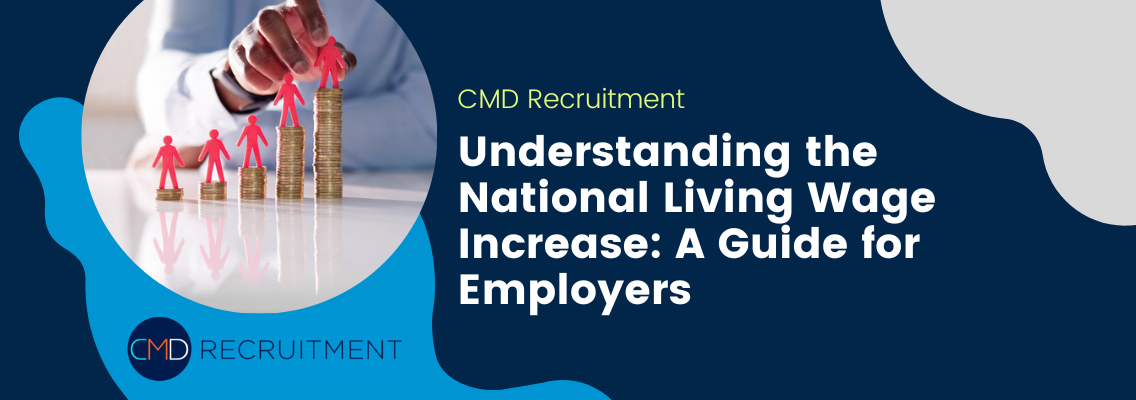With the cost of living on the rise, the government is taking action to make things a little easier for those on the lowest wages. With this in mind, we will see the National Living Wage rise this April, which could have widespread implications for employers.
For employers, understanding these changes is crucial not only for compliance but also for maintaining a motivated and productive workforce. In this guide, we delve into the implications of the National Living Wage increase, offering insights and recommendations for employers navigating this evolving landscape.
What is the National Living Wage?

The National Living Wage (NLW) is a statutory minimum wage rate introduced by governments to ensure workers receive a fair wage that reflects the cost of living.
It is distinct from the National Minimum Wage (NMW), as it is specifically aimed at providing a higher standard of living for workers aged 23 and over. The NLW is reviewed annually and adjusted in line with economic factors and living costs. This is set to impact the wages of over 2 million low-paid workers.

Why is the National Living Wage increasing?
The government regularly reviews the National Living Wage rate to make sure that it is adjusted in line with various factors such as inflation, economic growth, and living cost indices.
Employers need to stay informed about these changes to ensure compliance with the law and to properly budget for labour costs. You can guarantee that your employers are aware that these changes are coming, and they will be checking their pay slips to ensure the changes have been implemented.
Failure to comply with NLW regulations can result in financial penalties and damage to the employer’s reputation. These changes should be seen as a positive move for employers, as it will result in a boost in morale and productivity.

What are the implications for employers?
The increase in the National Living Wage has several implications for employers, including:
- Financial impact: The primary concern for employers is the financial impact of the NLW increase. Higher wage costs can affect profitability, particularly for small businesses operating on tight margins. Employers should conduct thorough financial analyses to understand the impact on their bottom line and explore strategies to mitigate any adverse effects.
- Workforce morale: Pay is a significant factor in employee satisfaction and morale. Offering a wage that aligns with the NLW demonstrates a commitment to fair compensation and can improve employee loyalty and retention. Conversely, failing to adjust wages accordingly may lead to disgruntled employees and increased turnover.
- Recruitment and retention: The current labour market is highly competitive, so offering competitive wages is essential for attracting and retaining hard workers. Employers who pay below the NLW may struggle to attract qualified candidates and may experience higher turnover rates as employees seek better-paying opportunities elsewhere.
- Compliance and legal risks: Failing to comply with these rules can lead to legal action, fines and damage to your reputation. Employers must ensure they are aware of their obligations under the law and take proactive steps to comply with NLW requirements. This may involve reviewing payroll practices, updating employment contracts, and seeking legal advice if necessary.

Recommendations for employers
To effectively navigate the National Living Wage increase, employers can consider the following recommendations:
- Budget planning: Incorporate NLW increases into annual budget planning to anticipate and mitigate the financial impact on your business.
- Review pay structures: Evaluate current pay structures to ensure compliance with NLW regulations and make adjustments as necessary to meet statutory requirements.
- Invest in training and productivity: Enhance workforce productivity through training and development initiatives to offset the impact of higher wage costs.
- Monitor legislation changes: Stay informed about changes to NLW legislation and other labour regulations to ensure ongoing compliance and avoid legal risks.
- Communicate with employees: Transparent communication with employees about National Living Wage increases and their impact on wages can foster trust and mitigate potential discontent.
Closing thoughts
The National Living Wage increase presents both challenges and opportunities for employers. By understanding the implications of these changes and implementing proactive strategies to comply with NLW regulations, employers can navigate this evolving landscape while maintaining a motivated and productive workforce.
Investing in your workforce makes good financial sense when you consider the costs of high employee turnover. If you are known for being a fair employer offering above market wages, you’ll have your pick of the best candidates. You’ll also enjoy the benefits of a more motivated workforce, as your employees will not be worried about making ends meet or looking for a second job.
